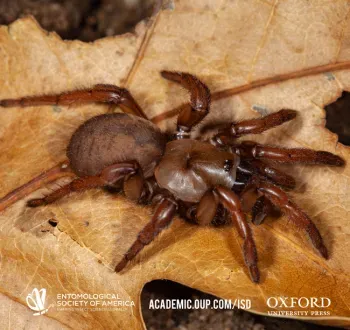
It's not often that a UC Davis scientist heads to Slovenia to share expertise on trapdoor spiders.
As a Fulbright Special Program award recipient, Professor Jason Bond is doing just that.
He's meeting with scientists and presenting talks at the National Institute of Biology (NIB) in Slovenia.
At UC Davis, Professor Bond serves as the Evert and Marion Schlinger Endowed Chair of Insect Systematics, Department of Entomology and Nematology; director of the Bohart Museum of Entomology; and executive associate dean of the UC Davis College of Agricultural and Environmental Sciences. He's also president of the American Arachnological Society.
One of Bond's presentations to NIB was titled "Genomic Perspectives on Mygalomorph Spider Systematics and Evolution." It was part of NIB's “Ecology and Evolution Doctoral Seminar Series 2025/2026."
In his abstract, Bond wrote: "The infraorder Mygalomorphae is one of the three main lineages of spiders comprising more than 3000 nominal species with a worldwide distribution that includes charismatic taxa such as tarantulas, trapdoor spiders, and highly venomous funnel-web spiders. The application of genomic data to long-standing taxonomic and phylogenetic challenges has been instrumental to resolving questions related to venom evolution, silk production and use, biogeography, adaptation to extreme environments, cryptic diversity and species delimitation, and evolution of life history traits."
The Mygalomorphae, or mygalomorphs, are an infraorder of spiders, and comprise one of three major groups of living spiders. They are found on all continents except Antarctica. Many members of the infraorder are trapdoor spiders, so named because they construct trap doors, or wafer-like, silk-and-soil trap doors over their burrows. When a trapdoor spider detects the vibration of a prey, it springs out, grabs it, and drags it into its burrow.

Bond discussed a number of recent phylogenomic studies which have made "significant progress in resolving relationships and establishing a newly revised familial level classification, as well as presenting new data employing Ultra Conserved Elements (UCEs) with expanded taxon sampling." However, despite major progress made over the last decade, key knowledge gaps remain, he told the crowd.
One of his topics was the new genus and species of trapdoor spider, Cryptocteniza kawtak, that he discovered in an isolated area of Moss Landing State Beach, Monterey County, California. "Cryptocteniza" combines two Greek words meaning “hidden or secret” (it was long undetected) and “comb” (referring to its comb-like spines near their jaws for digging). "Kawtak" means “seashore” in the language of Amah Mutsun Tribal Band, who originally lived on the lands near the spider’s habitat.
"Kawtak" came about as a result of a "Name-That-Spider" contest that drew some 200 entries from all over the world. Entomologist Kirsten Pearsons, a UC Davis alumnus who holds a doctorate in entomology from Pennsylvania State University, submitted the winning species name, “kawtak,” the Mutsun tribe name for "seashore."
Bond and his co-authors reconstructed the spider's evolutionary history: its extinction following the Miocene epoch, 23.03 to 5.3 million years ago and the establishment of a Mediterranean climate. “Owing to its phylogenetic distinctiveness, incredibly narrow distribution and age, we show that Cryptocteniza meets all the criteria of an ‘Endangered Living Fossil' and is consequently of grave conservation concern,” Bond said. (See Bug Squad blog, Oct. 7, 2020)
Panel Discussion Set on 'Modern Biodiversity Detection'
On Tuesday, Sept. 16, Professor Bond and NIB Professor Matjaž Kuntner will lead the "Modern Biodiversity Detection" presentation, comprised of a panel of international scientists discussing the modern approaches used to detect, describe, and preserve biodiversity. The panel includes NIB faculty members Denis Kutnjak, Nataša Mori, David Stanković, Timotej Turk Dermastia, and Al Vrezec, along with Professor Carolyn Malmstrom of Michigan State University and Hans Rewcknagel of the University of Ljubljana faculty.
NIB, established in 1960, is the third largest public research institute in natural sciences in Slovenia. It is known for its work the fields of general biology, plant physiology, organismal biology, ecology, and environmental protection biomedicine and biotechnology.
It's quite an honor to be a Fulbright Specialist Program award recipient.
Bond is one of some 400 U.S. citizens who share expertise with host institutions abroad through the Fulbright Specialist Program. Recipients of these Fulbright Specialist awards are selected on the basis of academic and professional achievement, demonstrated leadership in their field, and their potential to foster long-term cooperation between institutions in the U.S. and abroad.

